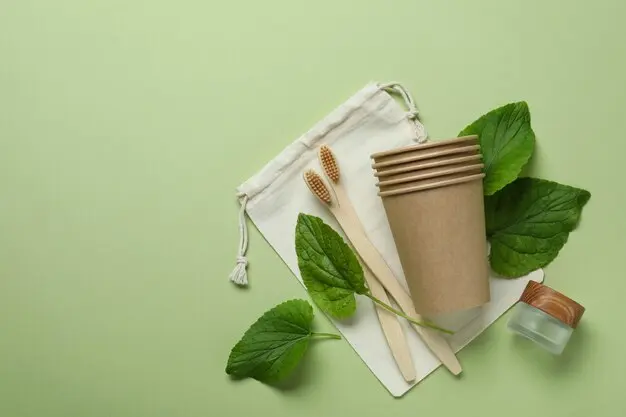In the quest for a more sustainable future, the term “biodegradable product” has become a buzzword in environmental discussions. But what exactly does it mean, and are these products truly better for the environment?
A biodegradable product is one that can be broken down by naturally occurring microorganisms, such as bacteria and fungi, into simpler substances. These products are designed to return to nature, reducing waste and potentially lessening the impact on our planet. However, the reality of biodegradability is more complex than it might initially seem.
This blog post aims to delve into the world of biodegradable products, exploring their benefits, drawbacks, and their real impact on the environment. We’ll also look at the science behind biodegradability, the different types of biodegradable materials, and the role of composting in the process. By understanding these aspects, we can make more informed decisions about the products we use and their environmental implications.
Stay with us as we unravel the truth behind the question: Are biodegradable products really better for the environment?
Key Takeaways
- Benefits of Biodegradable Products: Biodegradable products can reduce environmental impact, lower carbon footprint, and aid in waste management. They break down naturally over time, reducing the amount of waste that ends up in landfills.
- Drawbacks of Biodegradable Products: Not all “biodegradable” products break down effectively in all environments. Some biodegradable products can still contribute to pollution if not disposed of correctly.
- Biodegradable vs. Non-Biodegradable Products: Biodegradable products are designed to break down more quickly and naturally, reducing their long-term impact on the environment. Non-biodegradable products, particularly those made from plastic, can persist in the environment for hundreds of years and contribute to pollution.
- The Role of Composting in Biodegradability: Composting is a natural process that breaks down organic material into a nutrient-rich soil conditioner. It’s a key factor in the biodegradability of many products.
- Innovations in Biodegradable Products: The field of biodegradable products is constantly evolving, with new materials and technologies being developed all the time. These innovations aim to improve the performance of biodegradable products, reduce their environmental impact, and make them more accessible and affordable for consumers.
- Making a Difference: While the use of biodegradable products can be part of the solution to our environmental challenges, it’s important to remember that they are just one piece of the puzzle. Reducing our overall consumption, reusing items as much as possible, and recycling when reuse is not possible are all crucial components of a sustainable lifestyle.
Are Biodegradable Products Really Good For The Environment?
Biodegradable products are generally better for the environment compared to non-biodegradable alternatives, as they can break down naturally over time, reducing waste and lowering carbon footprint. However, their environmental impact can vary widely depending on factors such as the conditions in which they are disposed and the materials from which they are made. Some biodegradable products require specific conditions to decompose effectively, which are often only found in industrial composting facilities. Furthermore, if not disposed of correctly, some biodegradable products can contribute to pollution. Therefore, while they are a step in the right direction, they are not a silver bullet for environmental issues.
Understanding Biodegradability
Before we delve deeper into the topic, it’s crucial to understand what biodegradability entails. The term “biodegradable” is often used interchangeably with “compostable,” but there’s a significant difference between the two. While all compostable materials are biodegradable, not all biodegradable materials are compostable.
Biodegradability refers to the ability of materials to break down and return to nature. For a product to be considered biodegradable, microorganisms in the environment must be able to break down the material into natural substances such as water, carbon dioxide, and compost. However, the rate at which products biodegrade can vary greatly, depending on factors like temperature, moisture, and the product’s composition.
The Science Behind Biodegradable Products
The process of biodegradation involves breaking down materials with the help of microorganisms such as bacteria or fungi. When a biodegradable product is disposed of, these microorganisms consume the product as a food source, breaking it down into simpler organic molecules.
However, the rate at which this process occurs can vary widely, depending on the conditions and the materials involved. For instance, a leaf might decompose in a matter of weeks, while a wooden log could take years. Biodegradable plastics, on the other hand, require specific conditions to break down effectively, which are often only present in industrial composting facilities.
Types of Biodegradable Products
Biodegradable products come in many forms, from everyday items like food packaging and disposable cutlery to more specialized products like biodegradable golf balls or dog waste bags. The main types of biodegradable materials include paper, cardboard, certain types of plastic, and even some metals.
However, it’s important to note that just because a product is labeled as biodegradable, it doesn’t necessarily mean it’s eco-friendly. Some biodegradable products may not break down completely or might produce harmful byproducts during the breakdown process. Therefore, it’s essential to do your research and understand the impacts of the products you choose to use.
The Benefits of Biodegradable Products
Biodegradable products offer several potential benefits, both for the environment and for human health. Here are some of the key advantages:
Reduced Environmental Impact
- Biodegradable products break down naturally over time, reducing the amount of waste that ends up in landfills. This can help to conserve space in landfills and reduce the environmental impact of waste disposal.
Lower Carbon Footprint
- The production and disposal of biodegradable products often result in lower greenhouse gas emissions compared to their non-biodegradable counterparts. This can help to reduce our carbon footprint and combat climate change.
Waste Management
- Biodegradable products can be composted, which not only reduces waste but also creates a valuable resource. Compost improves soil health and fertility, promoting plant growth and reducing the need for chemical fertilizers.
The Drawbacks of Biodegradable Products
Despite their benefits, biodegradable products are not without their drawbacks. Here are some of the challenges and limitations associated with these products:
Limited Biodegradability
- Not all “biodegradable” products break down effectively in all environments. For example, some biodegradable plastics require specific conditions to decompose that are only found in industrial composting facilities.
Potential for Pollution
- Some biodegradable products can still contribute to pollution. For instance, if biodegradable plastics are not disposed of correctly, they can end up in the ocean where they break down into microplastics, posing a threat to marine life.
Misleading Labels
- The term “biodegradable” is often used in marketing and product labeling, but there is no universal standard for what this means. Some products labeled as biodegradable may not break down as easily or as completely as consumers might expect.
Biodegradable vs. Non-Biodegradable Products
When comparing biodegradable and non-biodegradable products, it’s essential to consider their entire lifecycle – from production to disposal.
Non-biodegradable products, particularly those made from plastic, have a significant environmental impact. They take hundreds, if not thousands, of years to decompose. During this time, they can cause harm to wildlife, contribute to pollution, and take up space in landfills.
On the other hand, biodegradable products are designed to break down more quickly and naturally, reducing their long-term impact on the environment. However, as we’ve discussed, the rate and completeness of this breakdown can vary widely depending on the product and the conditions.
For instance, consider the case of biodegradable plastics versus regular plastics. Regular plastic, such as PET (polyethylene terephthalate), never fully biodegrades. Instead, it breaks down into smaller and smaller pieces, eventually becoming microplastics that can be harmful to wildlife and ecosystems.
Biodegradable plastics, on the other hand, are designed to break down more fully over time. However, they often require specific conditions to do so – conditions that are typically only found in industrial composting facilities. In a home compost pile or a landfill, these plastics may not degrade much faster than regular plastics.
The Role of Composting in Biodegradability
Composting is a natural process that breaks down organic material into a nutrient-rich soil conditioner. It’s a key factor in the biodegradability of many products.
Composting not only reduces the amount of waste going to landfill but also returns valuable nutrients to the soil. However, not all biodegradable products are suitable for home composting. Some, like biodegradable plastics, require the higher temperatures of industrial composting facilities to break down effectively.
Innovations in Biodegradable Products
The field of biodegradable products is constantly evolving, with new materials and technologies being developed all the time. These innovations aim to improve the performance of biodegradable products, reduce their environmental impact, and make them more accessible and affordable for consumers.
One exciting area of innovation is in the development of biodegradable plastics. Traditional plastics are derived from petroleum, a non-renewable resource. They also persist in the environment for hundreds of years and contribute to pollution. Biodegradable plastics, on the other hand, are often made from plant materials and are designed to break down more quickly and completely.
For example, PHB (polyhydroxybutyrate) is a type of biodegradable plastic that has properties similar to polypropylene, a common type of plastic. PHB can be produced from methane, a potent greenhouse gas. By capturing methane that would otherwise be released into the atmosphere and using it to produce PHB, we can create a renewable, biodegradable plastic and help to mitigate climate change at the same time.
How to Make a Difference
While the use of biodegradable products can be part of the solution to our environmental challenges, it’s important to remember that they are just one piece of the puzzle. Reducing our overall consumption, reusing items as much as possible, and recycling when reuse is not possible are all crucial components of a sustainable lifestyle.
When choosing biodegradable products, do your research to ensure that they are truly biodegradable and that they are a better choice for the environment than the alternatives. Look for products that have been certified as compostable by a reputable organization, and make sure you know how to dispose of them properly.
In the end, the most sustainable product is often the one you didn’t buy. By focusing on reducing and reusing, we can minimize our impact on the environment and help to create a more sustainable future.
Conclusion
The journey towards a more sustainable future is complex and multifaceted. Biodegradable products offer a promising solution to the growing problem of waste, but they are not a silver bullet. While they can help reduce the environmental impact of our consumption, they must be used responsibly and in conjunction with other sustainable practices.
Understanding the science behind biodegradability, the benefits and limitations of biodegradable products, and the role of composting can help us make more informed decisions. By choosing products that are truly biodegradable and disposing of them properly, we can contribute to a more sustainable world.
However, it’s important to remember that the most sustainable choice is often to consume less, reuse more, and recycle when reuse is not possible. By incorporating these practices into our lives, we can make a significant impact on our planet’s health.
Frequently Asked Questions (FAQs)
What is a biodegradable product?
A biodegradable product is one that can be broken down by naturally occurring microorganisms into simpler substances. This process reduces waste and can potentially lessen the impact on our planet.
What is an example of a biodegradable product?
Examples of biodegradable products include certain types of food packaging, disposable cutlery, and yard waste like grass clippings and leaves.
What are some biodegradable products you use?
Many everyday products are biodegradable, including paper, cardboard, and certain types of plastic. However, the rate at which these products biodegrade can vary widely.
What is one example of biodegradable?
One example of a biodegradable material is paper. When disposed of properly, paper can be broken down by microorganisms in the environment, returning its components to nature.

